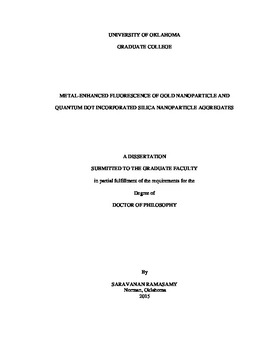| dc.contributor.advisor | Halterman, Ronald | |
| dc.contributor.author | Ramasamy, Saravanan | |
| dc.date.accessioned | 2015-05-07T14:31:09Z | |
| dc.date.available | 2015-05-07T14:31:09Z | |
| dc.date.issued | 2015 | |
| dc.identifier.uri | https://hdl.handle.net/11244/14585 | |
| dc.description.abstract | The enhancement of fluorescence intensity due to the proximity of metal nanoparticles is of great interest in enabling the detection of low concentration biomarkers. Although the recent developments in the optical sensor techniques pushed the sensitivity to the single-molecular detection, there is still an immense need for smaller and brighter sensor probes. Metal-enhanced fluorescence (MEF) is a promising strategy to amplify the signal from fluorophores by coupling to metal nanoparticles and significantly improve the potential of fluorescence based technology in bioapplications.
Gold nanoparticles are known for their ability to manipulate the incident light and generate a localized charge density oscillation called surface plasmon resonance (SPR). The concentrated electric field created around the metal surface by the SPR can dramatically increase the fluorescence brightness of nearby fluorophores by opening up additional excitation and emission pathways. Our research goal is to develop a solution based approach to study the metal-enhanced fluorescence by aggregating metal and fluorophore nanoparticles using organic linker molecules, which would ultimately lead to the ultra-bright fluorescent probes.
In the first part of our research, monodisperse gold nanoparticles (GNPs) of various diameters (15 - 60 nm) were synthesized using citrate reduction method and their photophysical properties were analyzed. The GNPs absorb and scatter in the visible light region with λmax between 515-545 nm. The place exchange efficacies of thiol and disulfide based hydrophobic ligand to replace water stabilizing citrate ions on the GNP surface were investigated. The amount of surface modified gold nanoparticles phase transferred from the aqueous to organic phase was measured using absorption spectroscopy to determine the efficacy of the place exchange. It took about 1 mM of 1,2-didodecyldisulfide to phase transfer 89% of GNPs.
The surface plasmon resonances of nearby GNPs can combine to generate even more concentrated electric field at their interparticle gap and the phenomenon is called plasmon coupling. This would cause a red-shift of absorbance band for the aggregated GNPs. We used this red shift in absorbance spectra to monitor the aggregation of gold nanoparticles. We developed a method of organic molecules mediated GNP aggregation in aqueous solution. We synthesized alkane chain ligand with amine and disulfide terminal groups to coat on GNPs’ surface and promote GNP aggregation by spontaneous or photo triggered activation of dithiocarbamate (DTC) moiety. The DTC mediated robust aggregates of GNP caused a red shift of absorbance peak from ~530 nm to beyond 580 nm. This red shifted scattering component of GNP aggregates can also be used to enhance the fluorescence brightness of the fluorophores placed in the interparticle gap.
Quantum dots (QDs) are fluorescent semiconductors with high photostability, high quantum efficiency and size tunable emission. They are attractive alternatives to the common organic dyes as the QDs have a broad excitation band and a narrow emission band. Since the MEF depends on the degree of spectral overlap between the metal and fluorophore, QDs with tunable emission would best fit for the study of MEF. Therefore, in the second part of our research we focused on synthesizing various size CdSe quantum dots cores (diameter 2.6 – 4.6 nm) and coated them with ZnS shell (overall diameter 7 nm) to create a highly stable and bright CdSe-ZnS core-shell QDs. In order to introduce water compatibility to the QDs, we developed a silica scaffold to encapsulate the CdSe-ZnS core. We produced different size silica nanoparticles (diameter 35 nm and 100 nm) by varying the thickness of the silica shell around the QD core in order to study the metal-fluorophore distance dependency of MEF. The silica nanoparticles were surface functionalized with various ligands containing dithiocarbamate terminal that have preferential affinity to gold surface to produce silica-gold heteroaggregation.
In the last part of our research we investigated the effect of size and concentration of silica and gold nanoparticle on the fluorescence enhancement. We were able to achieve a notable 3-fold fluorescence enhancement from the dithiocarbamate mediated heteroaggregates of 25 nm diameter gold nanoparticles and 100 nm diameter QD-doped-silica nanoparticles in aqueous solution. TEM images verified that the heteroaggregates of GNP and QD-doped-SiNP were enabled by the organic linker ligands. The excitation and emission spectra indicated that the fluorescence enhancement was due to the aggregation of multiple GNP around the SiNPs. The effect of different binding methods of gold to silica on MEF was investigated.
The construction and the controlled aggregation of functionalized gold and fluorophore-doped-silica nanoparticles would give an opportunity to advance the field of fluorescence based sensors. Our focus has been to take advantage of the fine-tuned synthetic control to synergize the special optical properties of the gold nanoparticles and quantum dots in a solution based approach to study MEF. | en_US |
| dc.language | en | en_US |
| dc.subject | Metal-enhanced Fluorescence, gold nanoparticle, quantum dot, silica nanoparticle | en_US |
| dc.title | Metal-Enhanced Fluorescence of Gold Nanoparticle and Quantum Dot Incorporated Silica Nanoparticle Aggregates | en_US |
| dc.contributor.committeeMember | Nicholas, Kenneth | |
| dc.contributor.committeeMember | Glatzhofer, Daniel | |
| dc.contributor.committeeMember | Yip, Wai Tak | |
| dc.contributor.committeeMember | Nanny, Mark | |
| dc.date.manuscript | 2015 | |
| dc.thesis.degree | Ph.D. | en_US |
| ou.group | College of Arts and Sciences::Department of Chemistry and Biochemistry | en_US |
| shareok.nativefileaccess | restricted | en_US |
